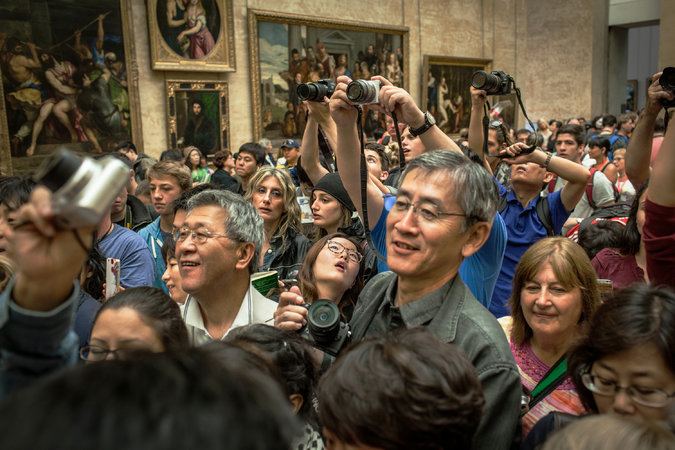Asher Kelman
OPF Owner/Editor-in-Chief
This morning, the New york Times published an article on the pressure key galleries in Europe have as hordes of visitors pack in to view their art treasures on display. The buildings aren't designed for the huge numbers of enthusiastic folk packing into spaces like this was the last subway train out of town before a "blackout" (....................or the sale of a new iphone "limited edition" with x-ray vision)!

New York Times: A crowd viewing the “Mona Lisa” at the Louvre in Paris, the busiest art museum in the world.
Credit: Guia Besana
Museum authorities are frightened for the paintings. Thousands of people in a room breathing out moisture and carbon dioxide does provide a constant carbonic acid vapor, not too good for the art! There are pickpockets working among the masses and from time to time the venus sculpture in London needs a finger replaced!
Still with 3-6 million of more visitors a year to each museum, the financial side of the equation is not mentioned in the NYT article, but, for sure, they love the cash flow!
The question I pose is this. How can one appreciate art when one is in a sea of people, perhaps in front of a Mona Lisa for 40 seconds and have "got the snap" with camera held up above the crowd, to move on to the next masterpiece to jostle for viewing angle and repeat the process.
Does each work of art have certain minimum requirements and conditions to be appreciated as "art", and thus able to elicit in us, some of the range of experience the artist intended. Does it matter that museums seem to be becoming "zoos for captured art" rather than places for pondering, enlightenment, meditation, musing, entertaining and energizing our imaginations. Or, perhaps, are my questions merely elitist? After all, the crowds are, at the very least, entertained!
After all, the picture was intended to be seen without all this commotion. One would presumably have time to take it all in and then perhaps share reactions with a friend and even come back to it several times more that afternoon. The sculpture of David by Michelangelo was sure intended to be walked around and admired from various standpoints, not snapped as a trophy like catching a goal scored in a football match!
We see this issue here showing pictures, meant for printing and placing on a large empty wall, being viewed backlit on our computer screens and we all know how difficult it can be to close the gap and provide the viewer the full "presence" of the work.
Read the entire NYT article here
I'd love your ideas and comments!
Asher

New York Times: A crowd viewing the “Mona Lisa” at the Louvre in Paris, the busiest art museum in the world.
Credit: Guia Besana
Museum authorities are frightened for the paintings. Thousands of people in a room breathing out moisture and carbon dioxide does provide a constant carbonic acid vapor, not too good for the art! There are pickpockets working among the masses and from time to time the venus sculpture in London needs a finger replaced!
Still with 3-6 million of more visitors a year to each museum, the financial side of the equation is not mentioned in the NYT article, but, for sure, they love the cash flow!
The question I pose is this. How can one appreciate art when one is in a sea of people, perhaps in front of a Mona Lisa for 40 seconds and have "got the snap" with camera held up above the crowd, to move on to the next masterpiece to jostle for viewing angle and repeat the process.
Does each work of art have certain minimum requirements and conditions to be appreciated as "art", and thus able to elicit in us, some of the range of experience the artist intended. Does it matter that museums seem to be becoming "zoos for captured art" rather than places for pondering, enlightenment, meditation, musing, entertaining and energizing our imaginations. Or, perhaps, are my questions merely elitist? After all, the crowds are, at the very least, entertained!
After all, the picture was intended to be seen without all this commotion. One would presumably have time to take it all in and then perhaps share reactions with a friend and even come back to it several times more that afternoon. The sculpture of David by Michelangelo was sure intended to be walked around and admired from various standpoints, not snapped as a trophy like catching a goal scored in a football match!
We see this issue here showing pictures, meant for printing and placing on a large empty wall, being viewed backlit on our computer screens and we all know how difficult it can be to close the gap and provide the viewer the full "presence" of the work.
Read the entire NYT article here
I'd love your ideas and comments!
Asher
